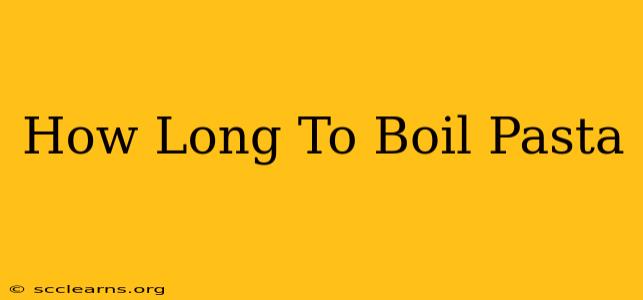Boiling pasta might seem simple, but achieving that perfect al dente texture requires precision and understanding. This guide will delve into the intricacies of pasta cooking time, ensuring you consistently produce delicious, perfectly cooked pasta every time.
Understanding Pasta Cooking Time
The cooking time for pasta varies greatly depending on several factors:
- Pasta Shape: Long pasta like spaghetti typically cooks faster than shorter shapes like penne or shells. This is due to the surface area exposed to the boiling water. Smaller shapes generally require less cooking time.
- Pasta Thickness: Thicker pasta strands need longer cooking times than thinner ones. Look closely at the pasta packaging; the instructions usually specify cooking time.
- Water Quantity: Using insufficient water can lead to uneven cooking and sticking. Always use a large pot with plenty of water (at least 6 quarts for a pound of pasta).
- Water Temperature: Bring the water to a rolling boil before adding the pasta. Adding pasta to lukewarm water will significantly increase cooking time and may result in mushy pasta.
- Salt: Adding salt to the boiling water is crucial. It seasons the pasta from the inside out, enhancing the flavor. Don't be shy with the salt!
Checking for Doneness: The Al Dente Test
The term "al dente" (Italian for "to the tooth") refers to the ideal pasta texture – firm to the bite, with a slight resistance. To check for doneness:
- Taste Test: The best way to gauge doneness is to taste a piece of pasta. It should be tender but still have a slight chewiness.
- Visual Check: Observe the pasta. It should be cooked through but not falling apart.
Avoid overcooking! Overcooked pasta becomes mushy and loses its texture. It’s better to slightly undercook and add a minute or two if necessary.
A Step-by-Step Guide to Boiling Pasta
- Bring the Water to a Boil: Use a large pot and fill it with plenty of water. Add a generous amount of salt.
- Add the Pasta: Add the pasta all at once, stirring gently to prevent sticking.
- Stir Occasionally: Stir the pasta occasionally, especially during the first few minutes, to prevent sticking.
- Check for Doneness: Start checking for doneness a minute or two before the time indicated on the package. Use the taste and visual tests described above.
- Drain the Pasta: Drain the pasta in a colander, reserving some of the pasta water. The starchy water can be used to create a creamy sauce.
- Serve Immediately: Serve your perfectly cooked pasta with your favorite sauce.
Troubleshooting Common Pasta Problems
- Sticking: If your pasta sticks, you may not have used enough water or you didn’t stir it often enough.
- Mushy Pasta: This usually means you overcooked it. Next time, check for doneness earlier.
- Uneven Cooking: This could indicate insufficient water or uneven heat distribution.
Pasta Cooking Time Chart (Approximate)
This chart provides general guidelines. Always check the package instructions for the most accurate cooking times.
| Pasta Shape | Cooking Time (minutes) |
|---|---|
| Spaghetti | 8-10 |
| Penne | 10-12 |
| Shells | 10-12 |
| Farfalle (Bowties) | 10-12 |
| Rotini | 9-11 |
| Fusilli | 9-11 |
Mastering the art of boiling pasta is a fundamental skill in the kitchen. By following these tips and tricks, you can consistently achieve perfectly cooked pasta, elevating your culinary creations to the next level. Enjoy!

